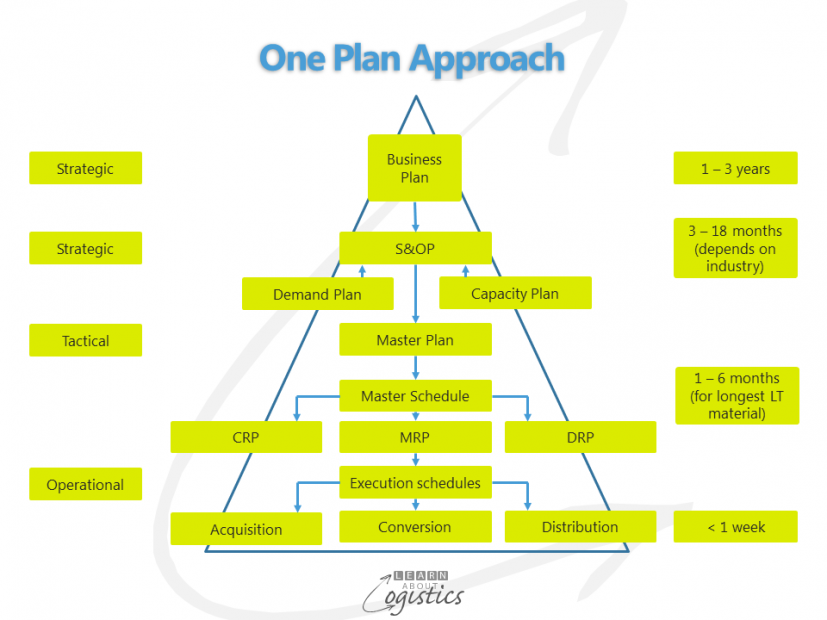Your One Plan.
Running around to ‘put out fires’ and reacting positively to challenging events looks good as a ‘can do’ attitude. Unfortunately, it is an ineffective and expensive way to operate; instead, try planning.
Planning is based on the ‘one plan’ approach – to be truly effective, your organisation must have only one plan. But, to be successful, all affected divisions, groups, functions and departments must have input to and understand the output decisions from the One Plan.
Your One Plan has four linked elements:
1. Business plan: to provide the framework for subsequent decisions and actions and generates functional strategies for Supply Chain (Procurement, Conversion and Logistics), Marketing and Finance
2. Sales & Operations Plan (S&OP): balances identified demand and available capacity
3. Master Plan: outputs from the S&OP to plan availability of stock keeping units (SKU), using materials, capacity and distribution planning tools
4. Execution Schedules: defines the order in which operational activities of acquisition, conversion and distribution will occur
Element 1 is strategic to the business and ‘owned’ by senior management. Element 2 is owned by senior management, but managed by the supply chain group, with all functions of the business involved. Elements 3 and 4 are managed by the supply chain group.

Elements of your One Plan
The business plan must be the focal point for thinking about and planning the future of the business. The plan provides a framework around which the subsequent function strategies are developed.
A great challenge for organisations across most product and service sectors is balancing the demands of their customers, consumers, patients or students with the available resources and capabilities.
A Demand (also called value) Chain has three objectives: develop products and services; acquire customers and retain customers. The role of a Supply Chain is to source inputs; convert (make) inputs to outputs and deliver the outputs. To balance demands with capacity requires a process that jointly plans these primary activities with the objective to improve sales, margins and profitability. This is S&OP.
Within S&OP, the term ‘sales’ includes the functions of marketing, product development, sales and demand planning. The term ‘operations’ incorporates procurement, conversion (which could be full production or just final assembly and test), logistics and technical support e.g. facilities and engineering; that is, the functions that work to supply products and services for sales.
Finance is the third arm of S&OP. For supply chains to be of value to the organisation requires the effective management of working capital, cash flow and international trade financing. The role of finance in the planning process is therefore vital.
S&OP is not complex, nor reliant on sophisticated software applications (although applications can assist). However, it has failed in many implementations because it relies on the ability of people to work as a team to implement a change in the way their organisation operates. If performance of the management team is not measured correctly, they will not behave to make S&OP work.
The Master Plan is the heart of the organisation, as the S&OP is the hub. Why? Because the Master Plan process is to plan individual SKUs through the veins of the organisation’s processes. The Master Plan capability incorporates (using generic terms) the Master Schedule, Materials Requirements Plan (MRP), Capacity Requirements Plan (CRP) and Distribution Requirements Plan (DRP). The complexity of each depends on how closely the organisation has structured its business as demand pull (i.e. JIT) or demand push. The more global the supply base, with longer lead times and higher minimum order quantities, the less reliance there can be on ‘kanban’ cards to pull materials through the supply chain processes.
Each planning period, the Master Plan takes the agreed S&OP plan as its primary input. The Master Schedule aim is that the aggregate planned outputs are used to balance the order requirements from sales and customers, together with some level of stability for importing, manufacturing and distribution.The Master Schedule provides the inputs for the MRP, CRP and DRP schedules.
In an ideal supply chain, elements of these schedules are used by suppliers as input to their S&OP process and those suppliers will do the same for their suppliers and so on. As it occurs, uncertainty is reduced, allowing organisations along the supply chains to reduce inventories, order quantities and lead times.
Output from the Master Planning process provides the customer service department with information concerning availability and lead times, based on the following criteria:
- Available in stock (AIS)
- the item is available for delivery within a defined geographic area
- Available to promise (ATP)
- the item is scheduled within the current production or import plan
- Capable to promise (CTP)
- the product can be planned if there is sufficient demand
- product, components or materials are available within a defined lead time
- there is available production or storage capacity and capability
- Capable to deliver (CTD)
- the following are available and acceptable for planning a product, if required
- transport mode and schedules
- transport lead time and variability
- transport nodes capacity and schedules
- the following are available and acceptable for planning a product, if required
Execution Schedules use outputs from MRP to establish the acquisition schedule (especially imports) for materials, components and products . The extent to which conversion and distribution schedules are actioned depends on the extent of the demand pull techniques used. If demand pull not used, the schedules identify the order in which input items will be converted to output products and the order of loading vehicles and moving inventory items. The execution schedules can be performed as part of a 3PL service, but the higher order planning should remain as intellectual property of your organisation.

